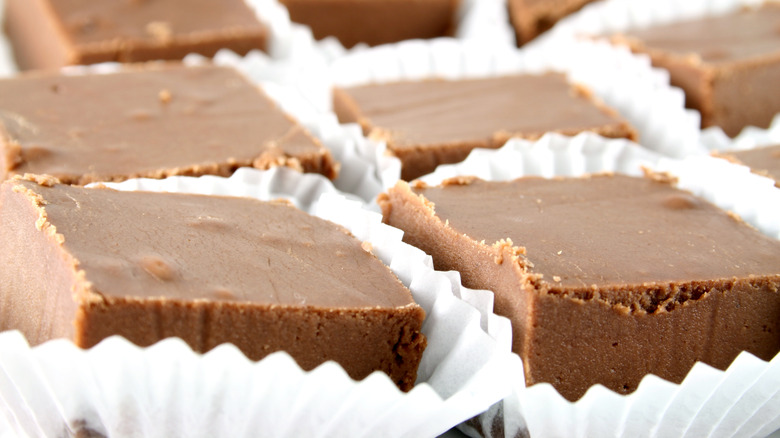How Long Does Fudge Last In The Fridge?
There has to be some magic involved in how cooking sugar, chocolate, and milk together yields something as decadent as fudge. Rich and chewy, yet also melt-in-your-mouth soft, it's good to eat on its own and can also be added to many other desserts to make even more scrumptious. That is why it's smart to whip up a sizable batch every time you make it — but what about storing them? The good news is fudge stays safe to eat even when kept at room temperature for a week or two. To make your next batch last longer, however, place any leftovers in the refrigerator to extend their storage life for up to 2 to 3 weeks.
To maintain its freshness for as long as possible, you must keep the fudge in an airtight container when storing it in the fridge. It protects this creamy dessert from absorbing the odors from other food items and also prevents moisture loss, which will cause the fudge to turn dry and crumbly during storage. If you have to stack your leftover fudge pieces, place a sheet of wax paper in between each layer to prevent air or condensation from seeping in, which will alter the quality negatively.
To further extend its longevity for 2 to 3 months, you can also wrap fudge securely in wax paper and foil then place it in a freezer bag to store in the freezer.
What are the signs that fudge has gone bad?
For most pastries, mold and rot are telltale signs of spoilage. These two don't really show up in fudge unless you make something like a dark chocolate and raspberry-flavored one or any other variety that calls for extra ingredients like chopped nuts, dried fruits, or jam. Since these add-ins come with their own shelf life, they increase the risk of mold developing if the fudge isn't stored properly. They can also give off an unpleasant smell once they turn bad so make sure to check your leftover fudge for any change in odor, too, before eating it.
In case you've made just plain and simple fudge, you would notice its overall quality declining as it gets older. A drier texture, especially around the edges, indicates staleness. If the fudge has gotten too dry that cracks have formed on its surface, it's time to throw it out. Similarly, improper storage in the fridge can lead to this dessert developing a slimy sheen.
Moreover, if you haven't secured it inside an airtight container and have placed it near the front of the refrigerator, the temperature change that happens whenever you open the door can form condensation on its surface. This can lead to sogginess, which makes fudge unpleasant to eat. Exposure to moisture also hastens its deterioration process. If you notice runoff liquid has already formed at the bottom of the container, discard the fudge immediately since it's already unsafe to eat.

